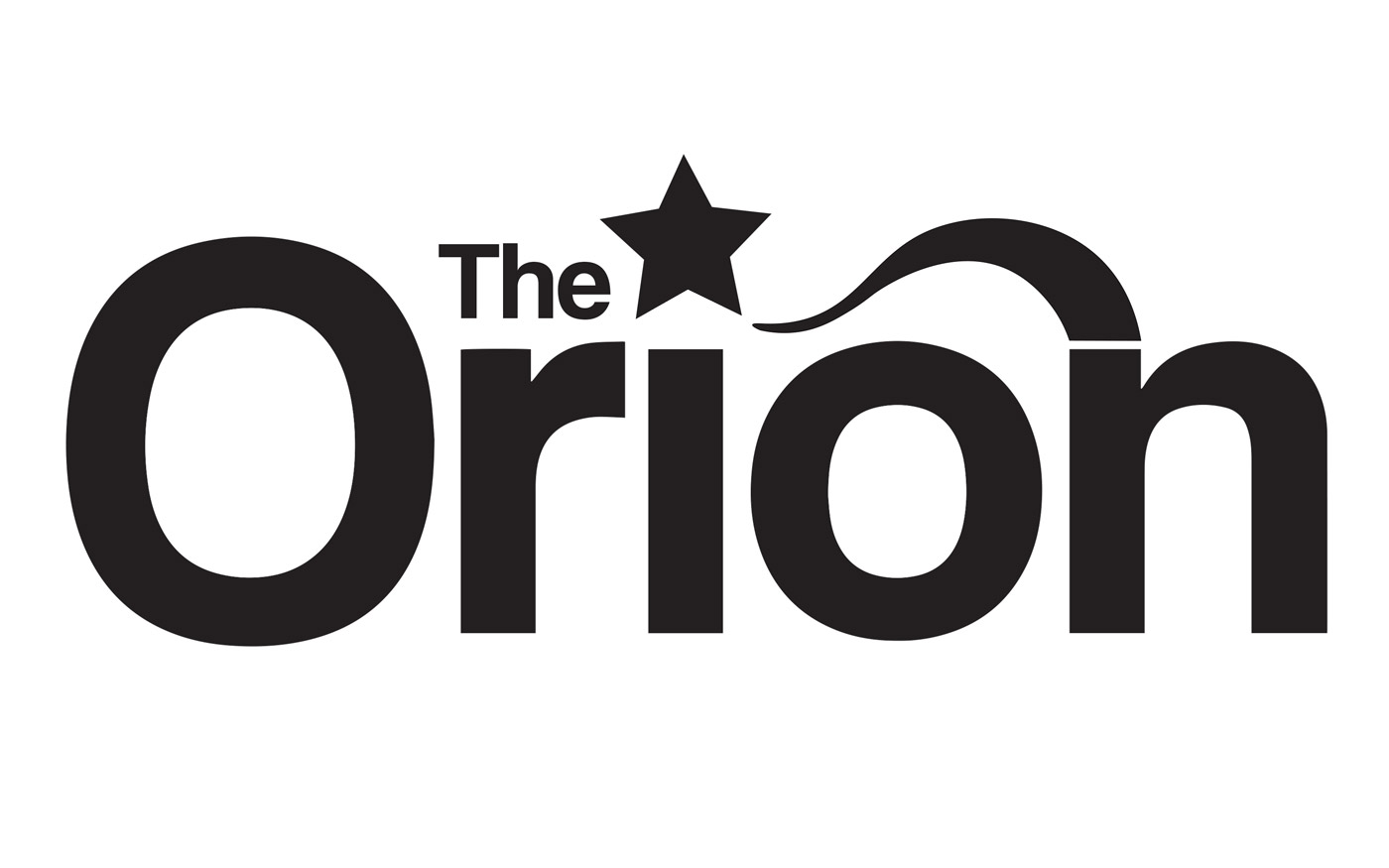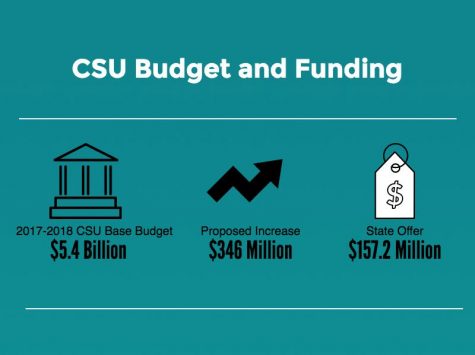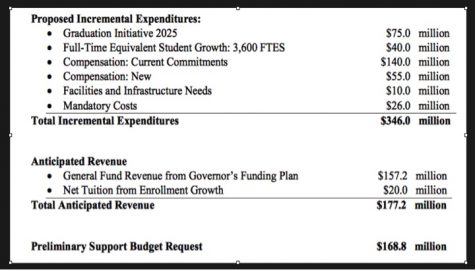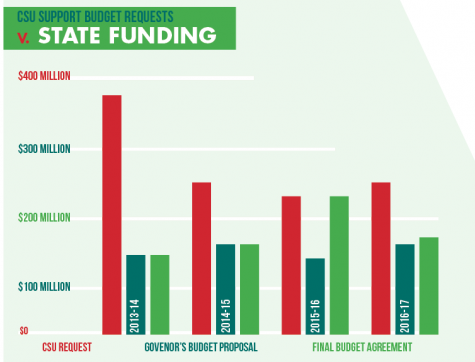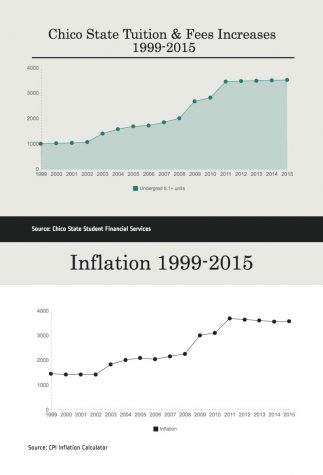Possible tuition increase for students
November 9, 2016
CSU students could pay 5 percent more in tuition next fall, according to a tuition proposal by CSU Chancellor Timothy White.
If the proposal passes, annual tuition would increase by $270 for undergraduates, $312 for credential students and $438 for graduate students.
The proposal will be discussed by the Board of Trustees at its Nov. 15 meeting. It will be voted on at its Jan. 31 meeting.
The CSU is currently funded at $5.4 billion a year. For its 2017-2018 budget, the CSU proposed $346 million in new spending, but Gov. Jerry Brown only included $157.2 million for the system in his budget.
the tuition increase would generate $77.7 million in revenue if passed and only account for 46 percent of the shortfall.
To partially make up the difference, the CSU will increase system-wide enrollment, which is expected to produce $20 million in revenue.
Still facing a $168.8 million shortfall, Chancellor White is submitting a proposal to raise tuition.
If approved by the trustees, the tuition increase would generate $77.7 million in revenue if passed and only account for 46 percent of the shortfall.
Chancellor White will continue to advocate that the State agree to fund the remaining shortfall, according to the proposal.
Class sections and campus services will be cut if the state legislature does not fully fund the CSU, the proposal states.
Chancellor White says the system needs the money to fund critical areas that support the “real needs” of the CSU.
Priorities for New CSU Spending
In the spending plan, Chancellor White outlines five priorities for new spending.
1. Graduation Initiative 2025: $75 million
The graduation initiative is a state-mandated program to allocate funding to programs that help students graduate on time, increasing graduation rates.
The CSU set specific goals to double graduation rates by 2025.
To do this, the CSU requested $75 million to “improve tenure-track faculty hiring, student-advisor ratios, eAdvising platforms, college readiness and use of data,” according to the proposal.
2. Enrollment Growth: $40 million
Due to an increase in applications from eligible students, the CSU is requesting money to raise the enrollment of full-time students by 1 percent, according to a Sept. 20 CSU Committee on Finance report.
CSU campuses currently serve 470,000 students, and 17 of 23 campuses are already experiencing issues of limited availability among first-year and transfer admissions and within major programs, according to CSU Impaction Information. This “impaction” means that the campus has exceeded its capacity and resources, and therefore must restrict enrollment.
Increased enrollment funding would create new sections of courses, pay for the hiring of new tenure-track and temporary faculty and provide more academic and student support resources, according to the tuition proposal.
3. Academic Facilities and Campus Infrastructure: $10 million
The CSU currently has a maintenance backlog of $2 billion for campus projects and the backlog will grow by $150 million per year as facilities age, according to the committee on finance report.
Furthermore, the tuition proposal states “55 percent of all CSU buildings are more than 40 years old.”
The CSU is requesting $10 million in recurring funds to address infrastructure projects.
4. Employee Compensation (Current and New Commitments): $195 million
To avoid the faculty strike last April, Chancellor White negotiated a 10.5 percent raise over three years with the California Faculty Association.
In last year’s budget, the CSU received $33 million in one-time funds to cover the costs of the agreement. This year, it requested $195 million to convert the one-time funding into its recurring budget.
To avoid a tuition increase and further need for state support, in the negotiations CFA proposed the CSU draw on its reserve of $2 billion to fund the raise for faculty members, CFA Chico Chapter President Timothy Sistrunk said. “(Chancellor White) said the reserve had already been committed. It’s in capital projects and stuff. They value the capital projects, the big money projects.”
In addition to the 10.5 percent raise for faculty, “administrators received a 5 percent raise, which shows (the CSU) could afford it,” Sistrunk said. “It’s just that they didn’t want to. They chose where to put the money. (CFA) wasn’t bargaining for (administrators).”
5. Mandatory Costs: $26 million
Mandatory costs include increased costs in employee health care and retirement benefits, and operation and maintenance of new buildings, according to the proposal.
The recent minimum wage increase also affects this area of the spending plan.
The Office of the Chancellor said it could not provide specific details for its spending plan within each of its five priorities.
“This has not been created yet because we don’t have the 2017-18 budget yet,” said Elizabeth Chapin, public affairs manager for the Office of the Chancellor. “This plan is preliminary. It is too early in the budget cycle.”
The Decline of State Funding
Since the 2008 recession, state funding support for the CSU has decreased.
According to the committee on finance report, “State investment in support of the CSU has moved from approximately 80 percent in the mid-1990s to closer to 50 percent by 2016-2017, with the remaining revenue provided by tuition and fees.”
To offset the effects of decreased state support, Prop 30 was proposed in 2012. The proposition, which was approved by voters, raised taxes on those making $250,000 or more a year and raised the sales tax to 7.5 percent.
Revenue from Prop 30 generated $8 billion in 2015-2016, according to California Budget and Policy Center. This revenue partially stabilized the state budget and shifted costs away from students and back to the state.
According to the committee on finance report, “The CSU has benefited from the state’s recovery with permanent, unallocated general fund increases of $637.8 million over the last four years.”
But, Prop 30 will expire in 2018.
Also, since 2013, the governor has provided incremental increases to CSU funds. These increases were offered on the condition that tuition not be raised and remain at 2012 levels.
However, the governor’s incremental increase plan expires this fiscal year, so the CSU is now considering a tuition increase.
The Rise in Tuition
Prior to the 2008 recession, tuition and fees increased a little at a time, according to data provided by Chico State Student Financial Services.
But in 2009, tuition for full-time undergraduate students at Chico State increased by $664, the largest single increase in 16 years of available data.
Then, in fall of 2011, tuition was raised by another $530.
Since, tuition and fees have remained relatively stagnant, increasing by $68 over four years. This is due to the freeze on tuition stipulated by the governor’s plan that increased funding for the CSU from 2013 to 2017.
According to California State Student Association President David Lopez, another freeze on tuition increases has not been discussed as a part of the new proposal.
Student Reaction
The California State Student Association, a student organization that consists of representatives from 23 campuses, met with Chancellor White twice to discuss the proposed tuition increase and ways it can be avoided, Lopez said.
the main obstacle we’re going to face is trying to get it to the state and say ‘hey, we are not traditional students, we all have different stories, and $270 might seem a little to you, but it’s a lot to us.’”
“We received a commitment from the Chancellor that the tuition increase would not go forward if the state fully funded the CSU,” Lopez said.
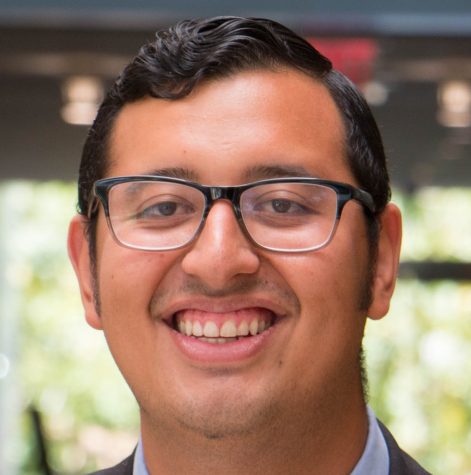
Courtesy of David Lopez
“We will have a plan to oppose the tuition increase and to focus on our state legislators,” he said. “They need to find an efficient way to fully fund (the CSU) this year and years to come.”
“We’re trying to develop this big coalition, but we actually all go to the Capitol and lobby and start telling stories, start telling the state that we’re not traditional students,” Lopez said.
“Some of my friends work two part-time jobs and go to school full-time,” Lopez said. “Some of them do that plus they have children and are married, and so it’s like there’s so much going on in their lives. And another $270 a year will probably add an additional five to 10 hours a week because $270 is going to affect them. That’s the $270 they use for textbooks and so on. And so the main obstacle we’re going to face is trying to get it to the state and say ‘hey, we are not traditional students, we all have different stories, and $270 might seem a little to you, but it’s a lot to us.’”
From the meetings Lopez has attended so far, he said the Board of Trustees doesn’t really know what to do. They’ll be more informed by their November meeting, but it could go either way, he said.
Students for Quality Education also recently announced it will hold a rally at the Nov. 15 Board of Trustees meeting to protest the tuition proposal. They started a social media campaign to collect student stories and organize students to fight the proposal.
The trustees will vote on the tuition increase proposal at their Jan. 31 meeting, but students won’t officially know if they will have to pay more in tuition until June 2017 when Gov. Brown submits his final budget, Lopez said.
Molly Sullivan can be reached at [email protected] or @SullivanMollyM on Twitter.
